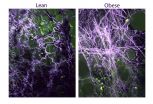INFORMATION:
Vanamala worked with Venkata Charepalli, a doctoral student; Sridhar Radhakrishnan, a post-doctoral scholar; Ramakrishna Vadde, a visiting scientist from India, all in food science and Lavanaya Reddivari, assistant professor of plant science, all from Penn State and Rajesh Agarwal, professor of pharmaceutical science, University of Colorado.
The United States Department of Agriculture supported this work.
Colorful potatoes may pack powerful cancer prevention punch
2015-08-26
(Press-News.org) Compounds found in purple potatoes may help kill colon cancer stem cells and limit the spread of the cancer, according to a team of researchers.
Baked purple-fleshed potatoes suppressed the growth of colon cancer tumors in petri dishes and in mice by targeting the cancer's stem cells. Colon cancer is the second leading cause of cancer-related deaths in the U.S. and responsible for more than 50,000 deaths annually, according to the American Cancer Society.
Attacking stem cells is an effective way to counter cancer, according to Jairam K.P. Vanamala, associate professor of food sciences, Penn State and faculty member, at the Penn State Hershey Cancer Institute.
"You might want to compare cancer stem cells to roots of the weeds," Vanamala said. "You may cut the weed, but as long as the roots are still there, the weeds will keep growing back and, likewise, if the cancer stem cells are still present, the cancer can still grow and spread."
The researchers, who released their findings in the Journal of Nutritional Biochemistry, currently online, used a baked purple potato because potatoes are widely consumed and typically baked before they are consumed, especially in western countries. They wanted to make sure the vegetables maintained their anti-cancer properties even after cooking.
In the initial laboratory study, the researchers found that the baked potato extract suppressed the spread of colon cancer stem cells while increasing their deaths. Researchers then tested the effect of whole baked purple potatoes on mice with colon cancer and found similar results. The portion size for a human would be about the same as eating a medium size purple-fleshed potato for lunch and dinner, or one large purple-fleshed potato per day.
According to the researchers, there may be several substances in purple potatoes that work simultaneously on multiple pathways to help kill the colon cancer stem cells, including anthocyanins and chlorogenic acid, and resistant starch.
"Our earlier work and other research studies suggest that potatoes, including purple potatoes, contain resistant starch, which serves as a food for the gut bacteria, that the bacteria can covert to beneficial short-chain fatty acids such as butyric acid," Vanamala said. "The butyric acid regulates immune function in the gut, suppresses chronic inflammation and may also help to cause cancer cells to self-destruct."
In addition to resistant starch, the same color compounds that give potatoes, as well as other fruits and vegetables, a rainbow of vibrant colors may be effective in suppressing cancer growth, he added.
"When you eat from the rainbow, instead of one compound, you have thousands of compounds, working on different pathways to suppress the growth of cancer stem cells," said Vanamala. "Because cancer is such a complex disease, a silver bullet approach is just not possible for most cancers."
The next step would be to test the whole food approach using purple potatoes in humans for disease prevention and treatment strategies. The researchers also plan to test the purple potatoes on other forms of cancer.
Using evidenced-based foods as a proper cancer prevention strategy could complement current and future anti-cancer drug therapies. Vanamala said that foods could actually offer a healthier way to prevent cancer because they often have limited side effects compared to drug treatments.
"Indeed, we have seen that the animals that consumed purple potatoes are healthier compared to animals that received drug treatment," said Vanamala.
Purple potatoes could be potentially used in both primary and secondary prevention strategies for cancer, Vanamala suggested. Primary prevention is aimed at stopping the initial attack of cancer, while secondary prevention refers to helping patients in remission remain cancer-free.
Most of the funding in cancer research currently goes to cancer cures but not to prevention, Vanamala said. However, as cancer incidences are predicted to surge in the next two decades, an equal emphasis on both food-based cancer prevention and therapeutic drug approaches should be used to counter the growing epidemic of cancer in the U.S. and around the world.
ELSE PRESS RELEASES FROM THIS DATE:
Stiffer breast tissue in obese women promotes tumors
2015-08-26
ITHACA, N.Y. - Women who are obese have a higher risk and a worse prognosis for breast cancer, but the reasons why remain unclear. A Cornell study published this month in Science Translational Medicine explains how obesity changes the consistency of breast tissue in ways that are similar to tumors, thereby promoting disease.
The study of mice and women shows obesity leads to a stiffening of a meshwork of material that surrounds fat cells in the breast, called the extracellular matrix, and these biomechanical changes create the right conditions for tumor growth.
The findings ...
New survey examines racial and ethnic differences in technology use by millennials
2015-08-26
A new study conducted by the Media Insight Project, a collaboration between the American Press Institute and The Associated Press-NORC Center for Public Affairs Research, found that while the similarities to the rest of their generation are numerous, there are some distinct differences in the way that Hispanic and African American Millennials use technology to access news and information. The source of their information is one area of difference: these young adults are more likely to use YouTube and Instagram for news than Millennials in general, though all groups rely ...
Neurodegenerative disease clogs nuclear pores
2015-08-26
Howard Hughes Medical Institute (HHMI) scientists have discovered how the most common genetic defect in amyotrophic lateral sclerosis kills nerve cells. Their study suggests that the pores that allow molecules into and out of a cell's nucleus get jammed, a finding that could speed the search for other genes that promote this fatal illness.
In people who have amyotrophic lateral sclerosis (ALS), the motor neurons that operate the muscles deteriorate. Over time, the disease deprives patients of the ability to walk, swallow, and breathe, and they usually die within three ...
Antimatter catches a wave at SLAC
2015-08-26
A study led by researchers from the U.S. Department of Energy's (DOE) SLAC National Accelerator Laboratory and the University of California, Los Angeles has demonstrated a new, efficient way to accelerate positrons, the antimatter opposites of electrons. The method may help boost the energy and shrink the size of future linear particle colliders - powerful accelerators that could be used to unravel the properties of nature's fundamental building blocks.
The scientists had previously shown that boosting the energy of charged particles by having them "surf" a wave of ionized ...
Capturing cancer
2015-08-26
They're among the most powerful tools for shedding new light on cancer growth and evolution, but mathematical models of the disease for years have faced an either/or stand off.
Though models have been developed that capture the spatial aspects of tumors, those models typically don't study genetic changes. Non-spatial models, meanwhile, more accurately portray tumors' evolution, but not their three-dimensional structure.
A collaboration between Harvard, Edinburgh, and Johns Hopkins Universities including Martin Nowak, Director of the Program for Evolutionary Dynamics ...
Methanotrophs: Could bacteria help protect our environment?
2015-08-26
New insight into methanotrophs, bacteria that can oxidise methane, may help us develop an array of biotechnological applications that exploit methane and protect our environment from this potent greenhouse gas.
Publishing in Nature, scientists led by Newcastle University have provided new understanding of how methanotrophs are able to use large quantities of copper for methane oxidation.
They have identified a new family of copper storage proteins called Csp that are present in a range of bacteria. These proteins store metal in a way that has not been seen previously ...
Scientists discover mechanism behind 'strange' earthquakes
2015-08-26
It's not a huge mystery why Los Angeles experiences earthquakes. The city sits near a boundary between two tectonic plates -- they shift, we shake. But what about places that aren't along tectonic plate boundaries?
For example, seismicity on the North American plate occurs as far afield as southern Missouri, where earthquakes between 1811 and 1812 estimated at around magnitude 7 caused the Mississippi River to flow backward for hours.
Until now, the cause of that seismicity has remained unclear.
While earthquakes along tectonic plate boundaries are caused by motion ...
Pacific Northwest wildfires severe in intensity
2015-08-26
The Pacific Northwest is abundantly dotted with wildfires in Washington, Oregon, Idaho and Montana. There are over 27 fires listed in the Inciweb database for the state of Washington. The largest active fire listed is the Okanogan Complex Fire which is currently at 256,567 acres and has 1,250 personnel working the fire. This fire began as a lightning strike on August 15, 2015. It is only 10% contained at present. Governor Inslee's request for a federal Emergency Declaration to provide additional resources to cover some of the costs related to multiple wildfires burning ...
Unusual use of blue pigment found in ancient mummy portraits
2015-08-26
Mostly untouched for 100 years, 15 Roman-era Egyptian mummy portraits and panel paintings were literally dusted off by scientists and art conservators from Northwestern University and the Phoebe A. Hearst Museum of Anthropology as they set out to investigate the materials the painters used nearly 2,000 years ago.
What the researchers discovered surprised them, because it was hidden from the naked eye: the ancient artists used the pigment Egyptian blue as material for underdrawings and for modulating color -- a finding never before documented. Because blue has to be manufactured, ...
UCSF researchers control embryonic stem cells with light
2015-08-26
UC San Francisco researchers have for the first time developed a method to precisely control embryonic stem cell differentiation with beams of light, enabling them to be transformed into neurons in response to a precise external cue.
The technique also revealed an internal timer within stem cells that lets them tune out extraneous biological noise but transform rapidly into mature cells when they detect a consistent, appropriate molecular signal, the authors report in a study published online August 26 in Cell Systems.
"We've discovered a basic mechanism the cell uses ...


